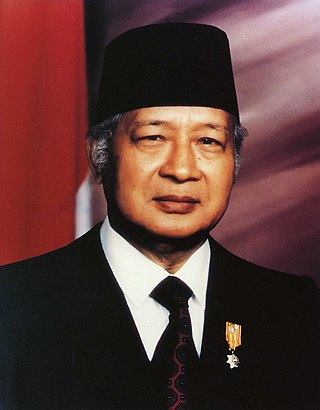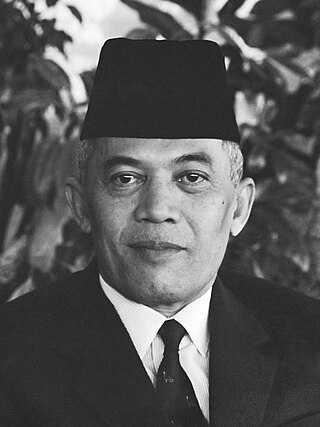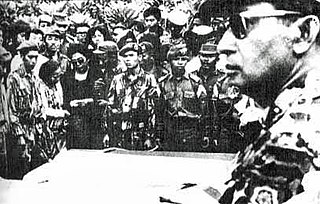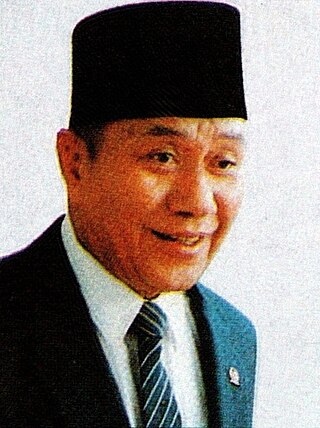Related Research Articles

Sukarno was an Indonesian statesman, orator, revolutionary, and nationalist who was the first president of Indonesia, serving from 1945 to 1967.

Suharto was an Indonesian army officer and politician, who served as the second and the longest serving president of Indonesia. Widely regarded as a military dictator by international observers, Suharto led Indonesia as an authoritarian regime from the fall of his predecessor Sukarno in 1967 until his resignation in 1998 following nationwide unrest. His 32-year dictatorship is considered one of the most brutal and corrupt of the 20th century.

Abdul Haris Nasution was a high-ranking Indonesian general and politician. He served in the military during the Indonesian National Revolution and he remained in the military during subsequent turmoil of the Parliamentary democracy and Guided Democracy. Following the fall of President Sukarno from power, he became the Speaker of the People's Consultative Assembly under president Suharto. Born into a Batak Muslim family, in the village of Hutapungkut, Dutch East Indies, he studied teaching and enrolled at a military academy in Bandung.

The term Government of the Republic of Indonesia can have a number of different meanings. At its widest, it can refer collectively to the three traditional branches of government – the executive branch, legislative branch and judicial branch. The term is also used colloquially to mean the executive and legislature together, as these are the branches of government responsible for day-to-day governance of the nation and lawmaking. At its narrowest, the term is used to refer to the executive branch in form of the Cabinet of Indonesia as this is the branch of government responsible for day-to-day governance.

Indonesia's transition to the New Order in the mid-1960s ousted the country's first president, Sukarno, after 22 years in the position. One of the most tumultuous periods in the country's modern history, it was the commencement of Suharto's 31-year presidency.

The People's Consultative Assembly of the Republic of Indonesia is the legislative branch in Indonesia's political system. It is composed of the members of the House of Representatives (DPR) and the Regional Representative Council (DPD). Before 2004, and the amendments to the 1945 Constitution, the MPR was the highest governing body in Indonesia.

The Order of Eleventh March, commonly referred to by its syllabic abbreviation Supersemar, was a document signed by the Indonesian President Sukarno on 11 March 1966, giving army commander Lt. Gen. Suharto authority to take whatever measures he "deemed necessary" to restore order to the chaotic situation during the Indonesian mass killings of 1965–66. The abbreviation "Supersemar" is also a play on the name of Semar, the mystic and powerful figure who commonly appears in Javanese mythology including wayang puppet shows. The invocation of Semar was presumably intended to help draw on Javanese mythology to lend support to Suharto's legitimacy during the period of the transition of authority from Sukarno to Suharto.

General (Ret) Amir Machmud was an Indonesian military general who was an eyewitness to the signing of the Supersemar document transferring power from President Sukarno to General Suharto.

Major General (Ret) Basuki Rahmat was an Indonesian general, National Hero and a witness to the signing of the Supersemar document transferring power from President Sukarno to General Suharto.

The president of the Republic of Indonesia is the head of state and head of government of the Republic of Indonesia. The president leads the executive branch of the Indonesian government and is the commander-in-chief of the Indonesian National Armed Forces. Since 2004, the president and vice president are directly elected to a five-year term, once renewable, allowing for a maximum of 10 years in office.

The Second Revised Dwikora Cabinet was the Indonesian cabinet which served under President Sukarno from March 1966 until July 1966. The cabinet was formed after Lieutenant General Suharto, using the powers that Sukarno gave to him through Supersemar, arrested 15 ministers from the Revised Dwikora Cabinet who were suspected of being sympathizers of the Indonesian Communist Party (PKI).

The Revised Dwikora Cabinet was the Indonesian Cabinet which served under President Sukarno from February 1966 to March 1966. The cabinet was formed under an extremely tense political situation, and it was expected that this Cabinet would address the concerns of the people. It was during a meeting of this Cabinet that unidentified troops surrounded the Presidential Palace causing to Sukarno to escape to Bogor from where he gave Supersemar to Lieutenant General Suharto.

The Presidential Decree of 5 July 1959 was issued by President Sukarno in the face of the inability of the Constitutional Assembly of Indonesia to achieve the two-thirds majority to reimpose the 1945 Constitution. It was army chief of staff Abdul Haris Nasution who concluded that this would be the only way to bring about the reintroduction of a constitution that paved the way for the military to play a greater role in the running of the state, ushering in the period known as the "guided democracy" (1959–1966).
Panglima is a military title used in Indonesia and Malaysia, and historically in the Philippines. It means 'a commander of a body of troops'. In the past it is used to call some prominent military leaders in several kingdoms, such as Panglima Polem from Aceh. In modern times it is reserved for the chiefs of the armed forces of Indonesia and Malaysia and some other posts.

The Chief of Staff of the Indonesian Navy is the highest position in the Indonesian Navy. The position is held by the four-star Admiral or Marine General, appointed by and reporting directly to the Commander of the Indonesian National Armed Forces. Chief of Staff is assisted by Vice Chief of Staff of the Indonesian Navy, position is held by three-star Admiral or Marine General.
The Greater Jakarta People's Militia was an irregular military unit active in Jakarta and surroundings during the Indonesian National Revolution. It originated as a group of radical youths, and later grew with organized crime groups and became a large irregular force in the outskirts of Jakarta.

President of Indonesia Decree of 23 July 2001 was issued by the fourth President of Indonesia, Abdurrahman Wahid, at the climax of his standoff with the People's Consultative Assembly (MPR) and other sections of society, including the Indonesian National Armed Forces (TNI).
The People's Consultative Assembly, the bicameral legislature of Indonesia, passed a series of resolutions of the People's Consultative Assembly or TAP MPR throughout the 1960s, to the very last issued in 2003.
Nasakom was a political concept coined by President Sukarno. This concept prevailed in Indonesia from 1959 during the Guided Democracy Era until the New Order, in 1966. Sukarno's idea of Nasakom was an attempt to unify various political ideologies. Nasakom attempted to unite the nationalist, religious, and communist groups that at that time had the most power in Indonesian politics.
References
- "Perintah Harian Presiden/Mandataris MPRS/Pangti ABRI/Pemimpin Besar Revolusi, Djakarta, 8 Maret 1966" (PDF). Monash Collections Online . 2017 [1966]. Retrieved 8 August 2021.
- Wardaya, Baskara T. (2007). Membongkar Supersemar! Dari CIA hingga Kudeta Merangkak Melawan Bung Karno[uncovering the Supersemar! From the CIA to the creeping Coup D'état against Bung Karno] (in Indonesian). Galang Press. ISBN 978-979-23-9909-7.